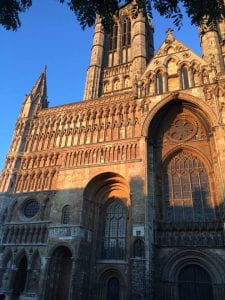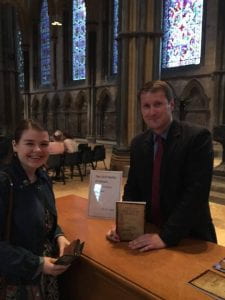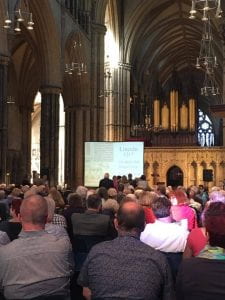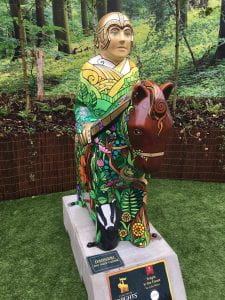
Ellie Lowe, an undergraduate BA History student at the University of Lincoln, has recently published her first book for the 800th anniversary of the Battle of Lincoln Fair and was kind enough to answer a few questions about this exciting opportunity:
What is your book about?
I was asked to write the book for the 800th anniversary of the Battle of Lincoln Fair, which is May 20th 2017. Despite being one of the most significant battles in England’s history, this event is relatively unknown compared to the likes of the Battle of Hastings. Many local residents see Lincoln as a small city in the modern day, but during the medieval period it was second only to London in terms of importance, and an bustling hub of trade and finance. Lincoln played a pivotal role in political affairs during this battle, and had the outcome been different it is very likely that a French king would have sat upon the English throne. As the book evolved it became a brief history of Lincoln itself, starting in the Roman period and ending in 1217, so readers will be able to gain a full understanding of the causes and consequences of the battle.
What/who encouraged you to publish this book?
I contacted a number of publishing houses in Lincolnshire looking for work experience in early 2016. Out of the several that I contacted, I only heard back from one, Tucann Design and Print in Washingborough. After sending a sample of my writing, I was asked if I’d like to write a short book on the Battle of Lincoln Fair for the 800th anniversary. This was such a great opportunity for me, and as I work for Lincoln Castle I know already knew a lot about the battle, so I accepted Tom Cann’s offer almost immediately.
How did you find the research process?
When I started I was only writing about the battle itself, and there is a chronicle by Roger of Wendover that I relied upon heavily, which was quite easy to understand. The event itself is often mentioned in passing but there are no major works written on it, which was the point of the book in the first place. Once it evolved to include a brief history of Lincoln I had to do a lot more research, and this has definitely helped me to build on my skills in this area.
Do you want to publish anything else in the future?
I wouldn’t say no to any future opportunities, but ultimately I’d like to work in the publishing industry rather than pursuing a career in writing. Although this process has really helped me to understand how the writer/publisher relationship works and I have gained valuable skills throughout the process.
What areas of history are you most interested in?
I am most interested in early modern history and my favourite modules at the University of Lincoln have been ‘Disease, Health and the Body in Early Modern Europe’ with Anna-Marie Roos, and ‘Accessing Ordinary Lives’ with James Greenhalgh and Helen Smith. I really enjoyed the content of both of these modules, and the freedom I had with my final assessments.
What do you have planned for your undergraduate dissertation?
My dissertation is going to be on public execution in the seventeenth century, and I am going to primarily explore how having wealth and status affected a condemned English citizen during this period. I will also research how the crowd reacted to executions, and whether this was different based upon the type of crime, and the type of person being executed.
Ellie’s excellent book is available for purchase from Waterstones Lincoln or the Lincoln Castle shop.
For more information on Ellie’s undergraduate work and experience as a student at the University of Lincoln, please have a look at her blog: https://elliemloweblog.wordpress.com!









 fascinating and made me think about the logistics of preserving history for future generations, not just in war zones (although, as Professor Stone suggests, this is important) but at local levels too. Many of the MA students in attendance at this seminar, myself included, are particularly interested in making ‘ordinary’ people aware that our culture heritage is everywhere and deserves to be protected. So, while his presentation was not directly focused on medieval history, Professor Stone raised some highly important points concerning the protection of cultural property.
fascinating and made me think about the logistics of preserving history for future generations, not just in war zones (although, as Professor Stone suggests, this is important) but at local levels too. Many of the MA students in attendance at this seminar, myself included, are particularly interested in making ‘ordinary’ people aware that our culture heritage is everywhere and deserves to be protected. So, while his presentation was not directly focused on medieval history, Professor Stone raised some highly important points concerning the protection of cultural property.












